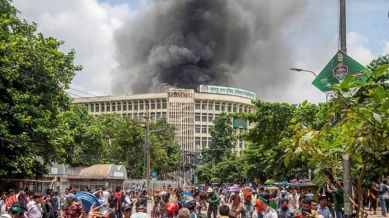Stay updated with the latest - Click here to follow us on Instagram
How protests and violence engulfed Bangladesh, forced Hasina to flee country
Bangladesh was born out of a war between India and Pakistan in 1971 in which nearly 3 million people were killed.

In a dramatic turn of events, Bangladesh Prime Minister Sheikh Hasina resigned and fled the country as violence against her government escalated on Monday leaving at least 300 people dead. Soon after, the Army chief Waker-Uz-Zaman addressed a press conference where he appealed the protesters to end the violence, and said an interim government will take charge soon.
However, unrest has often been reported in Bangladesh in over its five-decade history after the country was born out of a war in 1971.
monthly limit of free stories.
with an Express account.
What happened on August 5, 2024?
Student activists had called for a march to the capital Dhaka on Monday in defiance of a nationwide curfew to press Hasina to resign. As protesters began to march in some places, armoured personnel carriers and troops patrolled the streets of the capital, Reuters TV showed. In ensuing clashes, six people were killed.
As Hasina fled the country, television visuals showed thousands of people pouring into the streets of Dhaka in jubilation. Thousands stormed Hasina’s official residence ‘Ganabhaban’, shouting slogans and showing victory signs. Television visuals showed crowds in the drawing rooms of the residence, and some people could be seen carrying away televisions, chairs and tables from what was one of the most protected buildings in the country.
Protesters in Dhaka also climbed atop a large statue of independence leader Sheikh Mujibur Rahman, Hasina’s father, and began chiselling away at the head with an axe, the visuals showed.
What happened on August 4, 2024?
Clashes broke out Sunday morning when protesters attending the non-cooperation programme under the banner of the Students Against Discrimination with the one-point demand of Hasina’s resignation over a job quota system faced opposition from the supporters of the ruling Awami League, Chhatra League, and Jubo League activists.
At least 101 people, including 14 policemen, were killed in clashes on Sunday, leading Bengali-language newspaper Prothom Alo reported.
Student’s protests had turned deadly in July 2024 too
Bangladesh was engulfed by protests and violence that began last month after student groups demanded scrapping of a controversial quota system that reserved 30 per cent of government jobs for relatives of veterans who fought in Bangladesh’s War of Independence in 1971.
That escalated into a campaign to seek the ouster of Hasina, who won a fourth straight term in January in an election boycotted by the opposition.
Extremists targeted Hindus in 2021
In October, at least six people were killed and their houses destroyed in one of the worst instances of communal violence in the country in over a decade.
Militants attacked Dhaka’s diplomatic area in 2016
Militants attacked an upmarket restaurant in Dhaka’s diplomatic area, resulting in a 12-hour standoff, until it was stormed by the security forces. The deceased included nationals of Italy, Japan, the United States and India. It came after months of attacks on people advocating a liberal lifestyle in the country.
About 100 died in 2013 political violence
Around 100 people were killed in political violence under the Awami League party’s rule, by Sheikh Hasina, daughter of first prime minister Rehman.
Elections announced in November, and the hanging of a Islamic leader Abdul Quader Mollah, leader of the opposition Jamaat-e-Islami party for crimes during the 1971 war, resulted in nearly 100 more deaths.
Border guards killed 70 in Dhaka in 2009, mostly army officers
Unhappy with their wages and living conditions, border guards killed more than 70 people in Dhaka, most of whom were army officers. The “mutiny”, as it was called, which had spread to nearly a dozen towns, ended after six days as the angry guards surrendered following a series of discussions.
Born out of war
Bangladesh was born out of a war between India and Pakistan in 1971 in which nearly 3 million people were killed.
Its founding father and first prime minister Sheikh Mujibur Rehman was assassinated in 1975 in a military coup which brought in a long period of military rule.
With inputs from Reuters